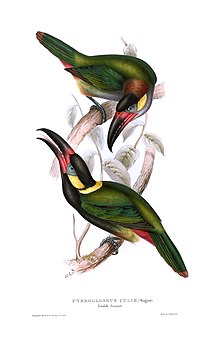Pepper eater
| Pepper eater | ||||||||||
|---|---|---|---|---|---|---|---|---|---|---|

Peppereater, males |
||||||||||
| Systematics | ||||||||||
|
||||||||||
| Scientific name | ||||||||||
| Selenidera piperivora | ||||||||||
| ( Linnaeus , 1758) |

The Pfefferfresser ( Selenidera piperivora , Syn. : Selenidera culik ) is a bird art from the family of toucans . The species occurs in South America. No subspecies are distinguished. As with all short-nosed toucans, there is a noticeable sexual dimorphism . Compared to other members of its genus, the pepper eater has short wings and a short tail in relation to its body size, and its beak is relatively long.
The IUCN classifies the pepper eater as not endangered ("least concern").
Appearance
Pepper eaters reach a body length of 32 to 35 centimeters and weigh between 129 and 171 grams. The males reach a wing length between 11.8 and 12.8 centimeters, the tail length is 9.5 to 11.2 centimeters. The beak length is 6.3 to 7.9 centimeters. Females have similar body dimensions, but their beak is slightly shorter at 5.6 to 7.0 centimeters.
The head, neck and chest of the males are black. The ear mark is yellow, a narrow band on the nape is orange-yellow. The back and wings are olive green, the thighs reddish brown. The under tail-coverts are red, the dark tail feathers have red-brown tips. The beak is dark gray to black, it is also red at the root and the lower half of the lower mandible. The featherless region around the eyes is blue-green. Females differ from males by the reddish brown neck band, a gray lower neck and a gray chest. Fledglings resemble adults , but their plumage is duller overall. This paler plumage is particularly noticeable in the dull red under tail-coverts.
There is no possibility of confusion with other toucan species: There are no other short-billed macaws in the range of the pepper eater, but the range borders on that of the Natterer-Arassaris . However, this one has a predominantly red beak.
distribution and habitat
The pepper eater occurs in northeastern South America. Its distribution area extends from Guyana and French Guiana as well as Suriname to the south of Venezuela and the north of Brazil . The pepper eater occurs predominantly in lowland forests. In Venezuela it is occasionally observed at altitudes of 900 meters, in Suriname it also occurs at altitudes between 600 and 800 meters.
The birds live mainly in the upper treetop regions of humid and wet tropical forests. They also colonize forests along rivers and sometimes mountain forests at lower altitudes. You prefer primary forest .
Way of life
The pepper eater is mostly found in pairs or in small groups. Several individuals can often be observed in fruit-bearing trees, but pepper-eaters do not form swarms. The diet consists mainly of fruits, but insects also play a role in the diet. The way of life is otherwise very little explored. From the observation of pepper-eaters in breeding condition and of young birds, one concludes that the breeding season falls between March and May.
supporting documents
literature
-
John Gould / Henry Constantine Richter : Monograph of the Ramphastidae, or the Family of Toucans , London 1854
- New edition with 51 color plates and a foreword by Jonathan Elphick : Taschen Verlag, Cologne 2011 ISBN 978-3-8365-0524-6
- Werner Lantermann: Toucans and Arassaris. Filander Verlag, Fürth 2002, ISBN 3-930831-46-5
- Lester L. Short and Jennifer FM Horne: Toucans, Barbets and Honeyguides - Ramphastidae, Capitonidae and Indicatoridae . Oxford University Press, Oxford 2001, ISBN 0-19-854666-1
Single receipts
- ↑ Selenidera piperivora in the Red List of Threatened Species of the IUCN 2013.2. Listed by: BirdLife International, 2012. Retrieved May 27, 2014.
- ^ Lantermann, p. 155
- ↑ Short et al., P. 342